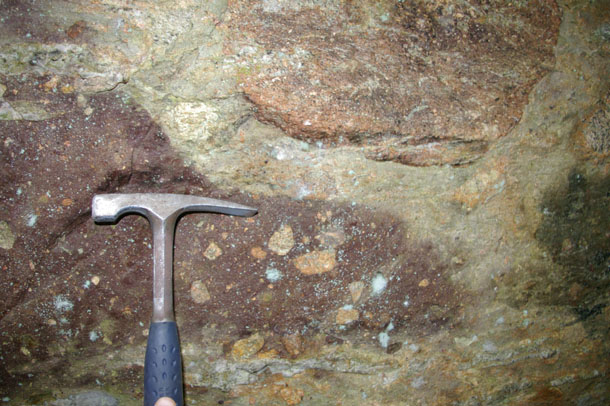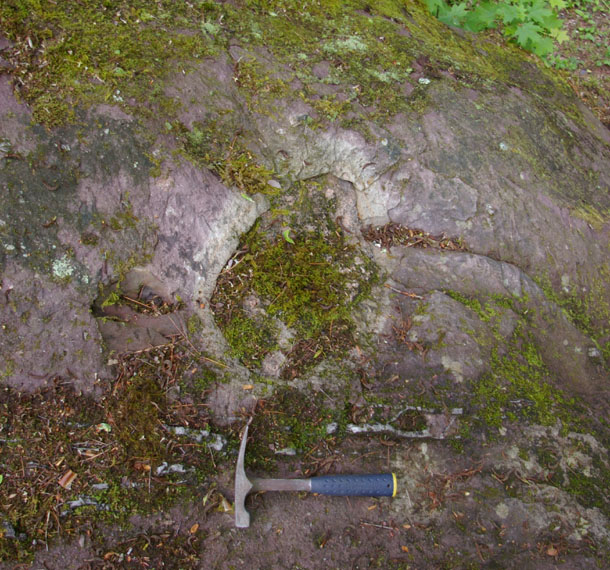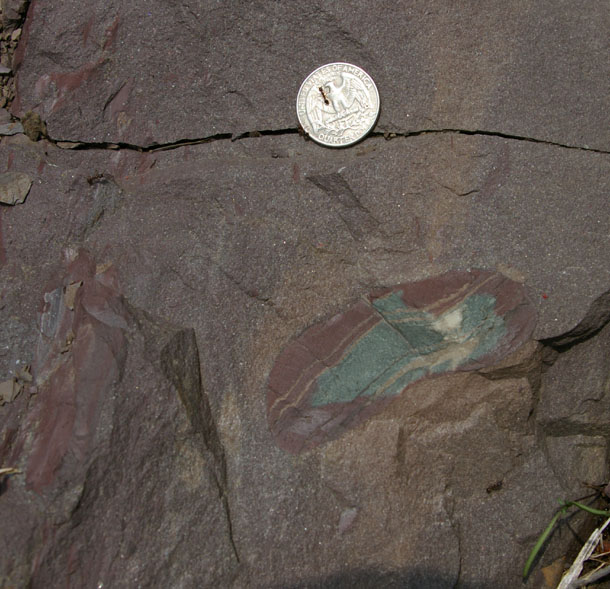Remember the Konnarock Formation from the other day? Let’s specifically go back to that diamictite unit up at the top. It’s got a very distinctive maroon color to its matrix. …Except where it doesn’t.
In some places, adjacent to large clasts, there is a light green “halo” or aureole around the clast — clearly a post-depositional reaction between the adjacent compositions of clasts and matrix.

Same thing in the photo below, but on a mossy boulder when the reaction-causing clast has weathered away faster than the matrix. You can tell where the clast is from its ghostly aura…

I’m tentatively interpreting this as a reduction reaction, the same sort of thing that makes reduction spots (like the one at the center of this image) but on a bigger scale. Most of the Konnarock shows the red colors we associate with oxidizing depositional conditions, but in these few areas, there are chunks which have a different chemistry from the bulk of the formation.
I’m not sure what the composition of the clasts is/are. In retrospect, it seems silly that I didn’t try to suss this out. While in the field, my focus was on the texture of the diamictite and not on diagenetic chemistry. I was just like, “Huh – interesting…” and snapped a quick photo with no additional probing. Then I moved on: it’s a pretty lame excuse.
With reduction spots, I’m used to thinking of a grain of pyrite or similar mineral as being the instigator of the reaction, but these big chunks in the diamictite aren’t obviously pyrite-bearing. Something else is probably making this happen… but I know not what.
Lastly, take a look at this image*:

This is a close-up of a mud chip rip-up clast in the lower Konnarock’s rhythmite section: it’s in one of the arkosic turbidite layers. The clast shows some interesting features: there’s the fine-scale “rhythmic” layering, and we can see some of the green layers that we previously interpreted as having been laid down under reducing conditions. But notice that the green doesn’t go all the way to the end of the layer, and furthermore there’s a little green offshoot to the top which cuts across the layering: again, this could potentially be a post-depositional reduction overprint on the middle of the clast.
Or could it be the opposite? That’s my take: maybe this clast started off as a layer of mud that was deposited under anoxic conditions. (Originally, it was all green.) Then it was scoured up by an oxygenated turbidity current and surrounded by this oxic sand slurry, it began to react. This created a maroon (oxidized) reaction rind that crept inward, utilizing “easy to flow through” pathways like bedding and fractures. The oxidation is the overprint in this interpretation, and the reduction is original.
If you know more about this stuff than I do (and that wouldn’t take much), let’s hear what you think of this. Thanks in advance for sharing your expertise.
*Bonus points if you noticed the (three) ants. And double bonus points if you noticed the spider mite just to the right of the clast.

0 thoughts on “Reduction rims?”